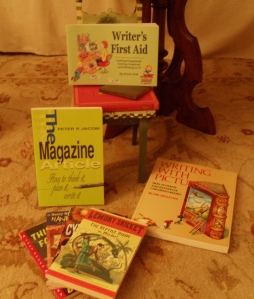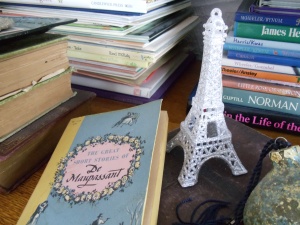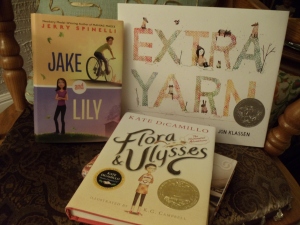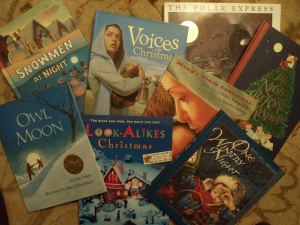new posts in all blogs
Viewing Blog: , Most Recent at Top
Results 26 - 50 of 112
Statistics for
Number of Readers that added this blog to their MyJacketFlap:

Photo by Vicky Lorencen
I knew I wasn’t crazy. (Hey, I saw that eye roll!) In her lecture about the interior life of our characters, young adult and middle grade author Coe Booth said, “Characters should exist before we know them. They should keep ‘talking’ when we aren’t writing about them.” Coe had no idea how good her words made me feel. I wasn’t the only one who thought that about my characters!
When I began my third middle grade novel, I interviewed the people I hoped would populate the story. My goal was to become better acquainted with my already-identified main character and his family as early in the novel-writing process as possible.
Why? Well, for one thing, we were going to spend a heck of a lot of time together. Why start out as strangers? Also (and this is a big ALSO), knowing my characters allows me to anticipate how they’ll think and feel in the situations I’ll plot for them.
Based on the interview outcomes for each player–primary and secondary–I compiled character sketches. Each character has a job to do and I had to know they were up for it. Slackers need not apply!
Oh sure, my characters have surprised me already–and that’s the fun part–but hosting that meet and greet for the entire cast at the outset made a big difference before we buckled up and motored into the unknown together.

Photo by Vicky Lorencen
Here’s my secret for a great character interview–turn off your inner censor. Unplug the darn thing and put your mouth on mute. Not unlike a brainstorming session where you agree there are no “good” ideas or “bad” ideas, the same must hold true as you query characters. LISTEN. Don’t interrupt or wonder if what they’re telling you is factual or even fits with the story you want to tell. Let your subconscious and your intuitive side have free rein. If you can do this, you will be amazed by what will surface. I recorded information about my characters and only afterward learned how the pieces fit together in powerful and significant ways I never could have planned or predicted.
Here are some sample character interview questions:
Who is your hero?
What’s your favorite day of the week? How come?
What’s under your bed?
What’s your earliest memory?
Do you have any allergies?
What candy is your all-time favorite?
If you could change your name, what would it be?
What’s your biggest fear?
What are you good at in school?
What do you wish you were good at?
When you look in a mirror, what part of your face do you like best?
What do you like to do when you get home from school?
Do you have a pet?
Do you have brothers or sisters?
How do you parents get along?
Who lives at your house?
What’s the best vacation or trip you’ve ever taken?
What seems unfair to you?
If you could live in another time in history, when would it be?
What ticks you off?
What rule would you change if you could?
What would happen if your best friend moved away?
What’s your least favorite chore at home?
Do you have a bad habit?
Do you like being hugged?
What would you do with $100?
Consider these questions for starters. I know you can think up even better ones (and please, feel free to share!)
Why not interview your characters too? Even if you’re mid-novel, it’s not too late to conduct an impromptu Q and A session. You may discover something that will add depth or quirkiness to your characters and “maybe” even help to explain why they do what they do (or aren’t cooperating).
But remember the secret–shift your censor into neutral. Let your characters delight, surprise and perplex you, and then they will do the same for your readers.
Every time I write a new book, I want to push myself to try something different. ~ Lauren Myracle


By: Vicky L. Lorencen,
on 6/4/2015
Blog:
(
Login to Add to MyJacketFlap)
JacketFlap tags:
Writing career,
Add a tag

Photo by Vicky Lorencen
Disclaimers before we dig in:
- Most of us do not enjoy being told what we must do, so if my musty list makes your writerly toes curl, you’re welcome to swap the word for something more appealing. Mush?
- If you identify yourself as a writer, I am going to assume you’re writing (just nod here), so I don’t need to include that on the must list.
- This list probably sounds all bossy pants, but that’s really more for my benefit. I need this list to keep me on track.
And now, on to the list . . .
By no means is this an all-inclusive list of musts, but it covers five of the biggies (for me anyway):
- You must remain true to your vision.
Now, hold on. I’m not talking about adopting a “My Way or the Highway” mentality. Hardly. I think it’s essential to be open to feedback and insights from voices you respect. What I am saying is, don’t be a sellout. Don’t compromise your integrity, your story and your characters for the sake of a byline. It won’t be your story any more. Don’t go creating regret.
- You must be kind.
And you know the kind I mean, right? Not the faux, syruppy, suck-uppy kind of kind. Genuine kindness, to me, is as much a part of being a professional as meeting deadlines. Being gracious and kind to everyone doesn’t just make you a well-liked writer, it’s what makes you a welcome member of the human race. Keep this must in mind when offering and receiving critiques, interacting with publishers or agents (and members of their support team), and whilst commenting on social media (that last one is a doozy, and sadly, the most often forgotten).
- You must express gratitude.
I’ve sent thank you for rejection letters. Yes. Seriously. You’re a kind person, so I bet you have too. If an editor took the time to read and consider my work, I want to acknowledge that even if we didn’t make a match. Send thank you notes or emails to fellow writers and industry professionals, to those who encourage you (and especially to those who send you treats). Express appreciation for opportunities and be grateful for the help you receive. You are pursuing your own dream. No one owes you a thing to help you achieve it. If they do assist you, don’t just be astonished, be thankful and say so.
- You must take risks.
How you define risk is up to you—reading at open mic, entering a contest, asking a question when it feels safer to sit in silence, revising based on some good advice even if you’re not certain you’ll like the result, trying a new genre, joining a critique group, creating a blog, going to a conference (or speaking at one!), hosting a writer’s meet-up, approaching an agent or submitting to your favorite editor. Venture out.
- You must give back.
Unless your name is Bob and you live in a pineapple under the sea, you can only be a sponge for so long, ya know? Soaking up is essential, but there comes a time when you’ve got to give yourself a good squeeze. Share what you’ve learned (when asked), volunteer and look for ways to benefit your fellow writers.
What about you? What are your professional musts? You simply must share. (There I go, all bossy pants again.)
In order to be irreplaceable, one must always be different. ~ Coco Chanel


By: Vicky L. Lorencen,
on 5/26/2015
Blog:
(
Login to Add to MyJacketFlap)
JacketFlap tags:
Agents,
Luck,
literary agent,
Encouragement,
Erin Murphy,
Writing career,
Risk-taking,
finding a literary agent,
EMLA,
Add a tag

Photo by Vicky Lorencen
You’ve had them. Those dreams of days that exist solely in your mind’s eye. You imagine how you’ll feel, what you’ll say or do as soon as the thing you’ve longed for a long time flips from fantasy to reality.
Then, that magical day arrives, and in a blink, you realize your mind’s eye was playing tricks on you.
It was like that for me earlier this month when my dream agent Erin Murphy offered to represent me. I was near tears, but then a surreal calm covered me. Not at all what I expected. I always assumed I’d hang up the phone and do a squeal/jump/cry combo. (Just picture it!) But I didn’t. I sat alone in my office in stunned silence. I’ve heard from friends who’ve had a similar experience.
Why? Well, I’ve pondered on that.
My best guess is that when your brain has been standing guard over your dream-holding heart for many years, it takes a bit before it can stand down and let your heart be happy. Your mind cares so much about your safety, it goes deaf to the cries of your heart that’s saying, “This is great news! Let’s celebrate!”

Photo by Vicky Lorencen
Thankfully, it only took about 24 hours before my mind unlocked my heart and I was free to be both grateful and giddy (yes, I even skipped down the hall with happiness).
Now, I know there’s still lots of work ahead, no guarantees and more opportunities for rejection, trail and error, and failure. My mind will still be busy watching over my heart, but for now, I’m delighted to enjoy this milestone.
Let me encourage you to celebrate your milestones too–sending out a submission you’ve spent many months (maybe years) preparing, making the shift from beer to champagne rejections (that is a big deal!), selling an article to a magazine you admire, getting that beloved book contract or whatever achievement makes your heart smile and your dear, overworked mind nod in agreement.
Remember to celebrate milestones as you prepare for the road ahead. ~ Nelson Mandela


You poured your very self, spleen and all, into your manuscript and you’ve sent it off to an editor. Now what? Well, while you wait for a verdict, there are any number of things you could do . . .

Photo by Vicky Lorencen
A Half Dozen Ways to Go Way Wrong While You Wait
1. Revise the manuscript you just submitted–either on-screen or in-brain. The deed is done (for now). Let it rest already.
2. Eat your weight in _____________. Even if it’s kale, uh, still not a gold-star idea.
3. Whine about the editor’s perceived lack of speed on Facebook/Twitter/And So On. These things take time. You know this. You are a marathon runner, not a sprinter. The same is true for editors. Now, do some stretches and drink your vitamin-infused water, Sweet Knees. Go to your Zenny place. That’s it. Breathe. Good.
4. Follow up too soon. You just planted a, oh, let’s call it a pumpkin seed. It will sprout. Trust the process. Fretting, pestering and pacing won’t help. An answer will come, maybe not the one that you want, but it will come (most likely).
5. Check your email 24/7 (a tactic formerly known as Stalking the Mail Carrier).
6. Drive your friends, family, sweetheart, coworkers and critique group bonkers. These are your A team, the folks who will celebrate with you or console you. Do not suck them into your swirling chartreuse vortex of neuroses any more than necessary, or at least evenly distribute your crazy, not unlike chocolate curls on a cupcake. See how pretty?
One and a Half Ways to Spend Your Wait Time Wisely
Jump into something new. Or revisit something old, perhaps a manuscript you were allowing to cool a bit. Can’t stomach the idea of actually writing another novel right now? That’s okay. Write an article. Pen a poem. Do research for your next novel. Interview your new characters. Piece together an outline or road map or even a grocery list of scenes or ideas for your next project. Keep moving.
Reward yourself. Do you know how many well-intentioned, would-be authors are out there with half-scripts fermenting in a folder? Neither do I. But the point is, you finished an entire manuscript. Then you had the audacity to send it to a real editor. What are you, a freak of nature? A Titan? That’s amazing. Reward yourself in a meaningful way. Yes, yes, I’m giving you permission. Why are you still reading? Shoo. Go celebrate you!
Rivers know this: there is no hurry. We shall get there some day. ~ A.A. Milne


By: Vicky L. Lorencen,
on 4/17/2015
Blog:
(
Login to Add to MyJacketFlap)
JacketFlap tags:
Giveaway,
Writing Techniques,
Add a tag

Photo by Vicky Lorencen
This time of year is an absolute boon for children’s writers. If you have children or grandkids, you’ll soon be attending award ceremonies, field days, banquets, carnivals, graduations, end-of-year parties or picnics. Well, when you do, be sure to take notes. These occasions are an All-You-Can-Record Detail Smorgasbord!
Oh, I know you think you’ll remember. You are wrong. Even if you take photos, many details will be spirited away. I am the mother of a high school senior. Benefit from my experience.
Write.
It.
Down.
Jot down the names of the various awards and how students react to them, the food and amusements offered at the carnival, how the banquet was decorated and what was served, choice sound bites you overhear, and what teachers say to regain crowd control. Take note of the popular (and the not-so-popular) kids are wearing and how they talk, the words to songs that are sung, the music being played at a ceremony, the names of the games being played (and so on and so forth and what have you).
These notes will become precious to you when you sit down to write. You’ll have a stockpile of details to bring your work to life and ground it in a reality that is so familiar to your readers. (Oh, and yes, you’ll have recorded dear details from your child’s school year, so there’s that too.)
The truth of the story lies in the details. ~ Paul Auster
Congratulations to the winners of the Frog on a Dime Spring Cleaning Giveaway . . .

Photo by Vicky Lorencen
Lindsay Fouts–winner of Writer’s First Aid: Getting Organized, Getting Inspired and Sticking to It by Kristi Holl
Danielle Hammelef–winner of Writing with Pictures: How to Write and Illustrate Children’s Books by Uri Shulevitz
Please contact me with your address and I’ll be delighted to send you your book!


By: Vicky L. Lorencen,
on 4/14/2015
Blog:
(
Login to Add to MyJacketFlap)
JacketFlap tags:
love of books,
Lemony Snicket,
Giveaway,
Richard Peck,
Henry Winkler,
Lin Oliver,
Encouragement,
Bruce Hale,
Uri Shulevitz,
Writing Techniques,
Kristi Holl,
Peter Jacobi,
Add a tag

Take your pick!
It’s time. As much as it pains me, I must purge my bookshelves a bit. Because I’m your fan, I want to share my purgings with you. Huh. That didn’t come out right, did it.
Moving on–we have a resource for non-fiction writers, one for picture book attempters, a practical book for any writer and (yes, there’s more) a set of brilliant middle grade novels by masters of the genre. And you thought this was going to be an ordinary day. Silly you!
Lean in and I’ll tell you how you can be a winner of the Spring Cleaning Giveaway: simply comment on this post and let me know which book (or books), you’d like to win. Then, I’ll draw names on Friday, April 17 at Noon. Easy sneezy.
Here’s what’s on the menu (and good luck deciding!) . . .
The Magazine Article: How to Think It, Plan It Write It by Peter Jacobi
This book was published in the late 1900s (makes it sounds really outdated, doesn’t it). What it lacks in advice about online research, it more than makes up for in how to add substance, depth and honesty to your work as a non-fiction writer. Plus, it’s Peter Jacobi. He’s amazing. If you ever get the chance to hear him speak, do. He’s a true orator. And can that guy write. Oh, my. Did I mention this book is signed? I almost hate to part with it.
Writing with Pictures: How to Write and Illustrate Children’s Books by Uri Shulevitz
This is a classic. If you write (or aim to write) picture books, you simply must have this book. It’s a treasure. And yes, I am willing to share it with you. Is that love or what?
Writer’s First Aid: Getting Organized, Getting Inspired and Sticking to It by Kristi Holl
I met Kristi ages ago at a Highlights Foundation workshop. This lady knows her stuff. While this little volume looks demure, it can be a real kick in the pants.
These fine middle grade novels, I’m offering as set. You can study them for craft, enjoy each as a fun, quick read and then share them with a child you love.
- A Series of Unfortunate Events, No. 2: The Reptile Room by Lemony Snicket
- Lost in Cyberspace by Richard Peck
- Hank Zipzer, The World’s Underachiever: Niagara Falls, or Does It? by Henry Winkler and Lin Oliver
- This Gum for Hire by Bruce Hale
Have you made up your mind? Don’t wait too long. Leave a comment by Noon on Friday and hopefully you’ll be a winner. Regardless, you are a fine person and there are plenty of kids who would be happy to sit by you at lunch. Remember, don’t slouch.
With freedom, books, flowers and the moon, who could not be happy? ~ Oscar Wilde


By: Vicky L. Lorencen,
on 3/31/2015
Blog:
(
Login to Add to MyJacketFlap)
JacketFlap tags:
Critique Group,
Kathi Appelt,
VCFA,
Vermont College of Fine Arts,
Writing career,
Writing Techniques,
Dana Walrath,
Distraction/Procrastination,
David McGinnis,
Joy Peskin,
Add a tag

Vermont College of Fine Arts
Photo by Vicky Lorencen

Kathi Appelt, David Macinnis Gill, Dana Walrath, Joy Peskin
Photo by Vicky Lorencen
You roll your quarters, register, and highlight the dates on the calendar. You pre-pick your plane seat and pack your bags. You’re going to a workshop! You look forward to it for months, fret about how many pairs of shoes to take, and finally, it’s time to blast off. I got to do just that earlier this month when I attended the amazing 12th Annual Novel Writing Retreat at Vermont College of Fine Arts. (If you’d like a great recap of the experience itself, I highly recommend visiting Debbi Michiko Florence’s site.)
I don’t know about you, but time passes at a sloth’s pace leading up to an event, but then the workshop itself whisks by at road runner speed. If you’re not careful (and by you’re, of course, I mean, I’m), it’s easy as gliding up an escalator to let the whole experience slip away once you’re back home.
Watch out for these post-workshop mistakes . . .
1. Rushing to query or submit your manuscript. Some writers think, if I don’t send that editor or agent my manuscript as soon as I get home, they’ll forget all about me. Not true, especially when you wisely offer a little reminder in the first sentence of your cover letter about how you met. Even if a presenter gives you a teensy window–like six weeks–to submit, take your time. Better to email a glistening, well-groomed manuscript, than to rush yourself and offer a schloppy copy. Your work is a reflection of you. Go for shiny, not speedy.
2. Neglecting your notes–if your notes are handwritten (mine always are), type them up. Seriously. It won’t take long, and while you’re typing, you’ll be reviewing the gems the presenters shared with you. It’ll be easy to highlight the parts that resonate with you too. [Next, pop some brackets around a hint or suggestion that perfectly applies to your WIP and cut/paste it into your ms. to serve as a reminder when you return to that section.] Don’t want to type? Use an old school highlighter or sticky notes to spotlight the bits you most want to recall. Put those pages (or copies of them) in the folder of goodies (research, hard copies, feedback) you’re compiling for this new novel. The idea is to incorporate every epiphany, aha and eureka into what you’re working on now, plus you’ll make them easier to find for future follies, that is to say, novels.

Photo by Vicky Lorencen
3. Disconnecting with the people who “clicked” with you. Friend them on Facebook, send a follow-up email or connect with them on LinkedIn. Send a text, a tweet or smoke signal, whatever works for you. These are your new peeps who share your passion. Passing on this chance to expand your circle is criminal, okay, well, at the very least, a pity.
4. Cooling off—you arrived home pooped, but positively giddy about a new idea for your WIP, but then your fervor fizzled. Family, your tyrannical to do list and Facebook eclipsed your euphoria. Don’t let them! If you have a critique group (or a beloved writing buddy), share what you learned with them. Talking about the lectures will help to solidify concepts in your mind. Your group/buddy may also be able to help decide out how to best use what you learned (and of course, you can return the favor). Ask someone to hold you accountable and offer to do likewise.
How about you? How do you keep the momentum moving after a workshop or retreat?
It is our choices, that show what we truly are, far more than our abilities. ~ J.K. Rowling



Photo by Vicky Lorencen
Let’s say a real estate agent sends you one of those slick postcards, inviting you to an open house on Sunday. You’re not really in the market for a house, but the agent’s photo is so endearing, and well, there might be cookies, so you and your beloved make plans to go. You show up between the hours of 2 and 4, and there stands the darling real estate agent—on an empty plot of land.
You and your sweetie make simultaneous brow furrows and head scratches. Wrong address? Then one of you suggests, perhaps she’s going to walk us over to that quaint house next door. Maybe she was so excited to usher us into our new dream home, she waited outside. You both exit the car and approach the agent. She nods and laughs at your quizzical faces. “Yes, yes, this is the right address,” she assures you. “But there’s no house here. Not yet.” You two do a simultaneous brow lift. “Heavens,” she says, “It’s still in the design phase.”
What? Doesn’t that sound loony–to seek buyers for a house that only exists in the mind of the architect? Why, yes, indeed it does. But you know what? (Uh oh, here she goes . . . )
It snaps my heart in two when I see people who are new to children’s writing splintering their time in unproductive ways. (Probably because I hate seeing them repeat some of my own dundering blunders.) And while I hate calling a story a product, if you plan to sell it, it is. It would stand to reason then that one must have a product to sell before one goes to market. Yes?
So, please, please . . . you’ve got me down on my old knees here . . . if you are new to writing for children, pretty please with Nutella on top, place your focus on crafting not publishing.
Here’s where your focus needs to be (according to yours ever-truly):
- Craft–first-drafting, revising, sharing with your critique group, revisiting and polishing
- Establishing good writing habits and routines
- Asking questions
- Attending conferences and workshops centered on writing (not publishing)
- Networking–yes, online, but also at retreats and what-have-yous
- Joining or establishing a critique group
- Reading books, blogs and articles on craft
- Reading books in your genre of choice
- Reading books outside your GOC
- Cultivating interests and experiences away of writing–dance, gardening, making pickles–anything that widens your world a bit
- Maintaining a positive online presence
Please don’t divert your precious writing hours by:
- Spending time and money learning how to give a stellar school visit
- Searching for an agent (they need a polished product to take to market first!)
- Submitting manuscripts (do not rush the process, let your manuscripts cool and mature)
- Hunting for an illustrator (that’s the art director’s job)
- Practicing your autograph (okay, well, it is fun, I’ll grant you that)
- Drafting your Newbery acceptance speech (but I do admire your radiant self-confidence)
- Investing metric tons of energy into building a fancy web site and online platform*
*Okay, you got me there. You may have noticed, since you are reading this after all, that I myself have a blog. Am I published? Well, no. Not yet. But I do see value in having a site for several reasons–it gives me a way to share ideas, offer encouragement and connect with other writers, it makes me feel more like a professional writer, and yes, it is a means to building a wee online presence for myself (even if it is the size of a frog on a dime). So, go ahead and create a blog or web site, but only if you really want. Don’t feel pressured to do it and certainly do not let it gobble up your writing time.
Focus on craft when you’re starting out, and then, once you’re more established, you can focus on craft (some more).
Time flies like an arrow; fruit flies like a banana. ~ Anthony G. Oettinger


By: Vicky L. Lorencen,
on 3/15/2015
Blog:
(
Login to Add to MyJacketFlap)
JacketFlap tags:
mixed bag,
Add a tag
 Vicky L. Lorencen:
Vicky L. Lorencen:
Next weekend I’ll be cramming a carry-on and heading to fabulous Vermont College of Fine Arts and sure enough . . .
 Originally posted on frog on a dime:
Originally posted on frog on a dime:
 Finn the Kitten relates
Finn the Kitten relates
Photo by Vicky Lorencen .
Freak out. Meltdown. Keyed up. Pick a label. Doesn’t matter. It’s here–the pre-event emotional mixing bowl of jitters, doubt and insecurity, with just a pinch of dread. Holy synopsis, it’s the night before school starts all over again.
Seems any time I’m heading for a writing event—a conference, retreat, class, workshop or seminar, all of my irrational thoughts tap into their stash of steroids and pump themselves up to Library of Congress sized proportions. They tell me lie after lie about myself and my abilities (or lack thereof) until I am left feeling unworthy, talentless and ill-equipped. Maybe even a little gassy.
Why am I telling you all of this? You never feel this way. You approach every new opportunity with the confidence of a peacock.
Um, don’t you?
If there is a sliver of a chance you can relate, allow…
View original 390 more words



Photo by Vicky Lorencen
Silver Bay, Adirondak Mountains in Lake George, NY
Studying the menu at a new restaurant can be tantalizing. You scan the appetizers: olive tapenade, baked brie and calamari, then peruse the main course options: lamb chops, tilapia, steak medallions, and finally the scrumptious desserts: peach pie, crème brulee or chocolate lava cake. So many choices. Sometimes it helps to ask your server for a recommendations.
Well, my charming writerly friends, I have a different menu of options to tempt you. I can personally attest to the high quality and value of each. You simply cannot make a bad choice (unlike that unfortunate experience with the ahi tuna sushi special. Sorry to bring that up again. Ew.). Any one of these will nourish your writing skills and expand your network (without expanding your waistband!) Because you can click the links to get all of the particulars, I’ll focus on my personal experience with each.
Highlights Foundation
Whether you write picture books, novels or non-fiction, you will find an outstanding collection of workshops with top-notch faculty hosted in the gorgeous natural surroundings of Pennsylvania. The Highlights team will treat you like gold and feed you like royalty. Presenters take a personal interest in your work and the small workshop sizes allow you to get to know the other participants and learn from them as well. Workshops are pricey, especially if you need to fly, but Highlights does offer scholarships, free shuttle service and makes the experience all-inclusive, so there are no extras to worry about beyond getting there. I loved it!
Vermont College of Fine Arts
You probably already know about VCFA’s two-year low residency MFA program. But do you know there are also weekend workshops? What made this workshop a standout for me was the exuberantly positive atmosphere. The faculty–simply fabulous too. Truly. I came away feeling pretty darn giddy. I’m going again later this month and I can’t wait!
Falling Leaves/Green Leaves Master Class Retreats
Hosted by the Eastern New York Chapter of the Society of Children’s Book Authors and Illustrators, these fall and spring weekends take place on magical Silver Bay in Lake George, New York. This retreat has an amazing participant:presenter ratio–35:5. It’s no surprise, spots fill quickly. This workshop will stretch you and give you a boost.
UCLA Extension Writers’ Program
This online program pairs you with an instructor and a small group of students. I took a course called “Creating Memorable Characters,” which included textbooks and novels to read, as well as the expected homework. Interacting with the instructor and with the other students who were from all over the planet made this course especially fun.
I’ll give you a moment to look over the menu. If you have any questions, please let me know. I’m happy to serve you. Bon appetit!
Hors d’oeuvres have always had a pathetic interest for me. They remind me of one’s childhood that one goes through wondering what the next course will be like–and during the rest of the menu one wishes one had eaten more of the hors d’oeuvres. ~ H.H. Munro


By: Vicky L. Lorencen,
on 2/22/2015
Blog:
(
Login to Add to MyJacketFlap)
JacketFlap tags:
mixed bag,
Add a tag
 Vicky L. Lorencen:
Vicky L. Lorencen:
A perennial topic, worth revisiting . . .
 Originally posted on frog on a dime:
Originally posted on frog on a dime:
Up until recently I believed I had green eyes. (Even my driver’s license says so.) But then, my redheaded, hazel-eyed daughter insisted my eyes are blue. So, at my last optometrist appointment, I asked my doctor to confirm once and for all that my eyes are indeed green. (You know, just to set the matter to rest with an expert opinion.) Turns out, my eyes are . . . blue. Truly green eyes, according to my doctor, are rare.
Of course, there’s another kind of green eyes that isn’t so rare–the green eyes of that monster called jealousy. Now, I know I’m poking around in a touchy topic. Jealousy is, well, it’s embarrassing. It makes us feel small, immature and vulnerable. Nothing pretty about that.
Jealousy is an especially sensitive issue among children’s writers. It’s been my experience that we are an exceptionally supportive bunch. We’re not “supposed” to be…
View original 438 more words


By: Vicky L. Lorencen,
on 2/17/2015
Blog:
(
Login to Add to MyJacketFlap)
JacketFlap tags:
Cynthia Leitich Smith,
Encouragement,
Lisa Wheeler,
Monica Harris,
Boosting confidence,
Kelly Barson,
Catherine Bieberich,
Jennifer Whistler,
your super power,
Add a tag

Photo by Vicky Lorencen
In 2013, I was fortunate to receive a critique from the lovely and ever-encouraging YA author Cynthia Leitich Smith. After reviewing the opening chapter of my second middle grade novel, Cyn told me humor was my super power. Me? I have a SUPER power? Well, if I have one, I know for certain you do too.
Maybe your super power is . . .
- Writing realistic dialogue
- Riding that fine line between sweet and sentimental
- Creating rich, other-worldly settings
- Weaving intricate, suspenseful plots
- Concocting quirky, but believable characters
- Being just plain funny
- None of the above–it’s your own proprietary blend
It’s always easier to pinpoint someone else’s super power, isn’t it. My friend Lisa Wheeler is a whiz with rhyme. Catherine Bieberich and Kelly Barson are able to strike a perfect balance between heart and humor. Jennifer Whistler crafts novels with a highly visual, cinematic quality. Others, like Monica Harris, are grand researchers who cull little-known tidbits from old texts to make even snoresville non-fiction topics intriguing.
What’s the point in knowing your super power? Well, as with a lot of things, it’s empowering to have a “go to”—like that perfected dish you can always whip without worry or that compliment-winning outfit in your closet. You can’t make lemon chicken piccata or wear that same suede jacket every day, but when the time is right, it’s confidence-building to know it’s there when you need it.
You can’t lean on your superpower for everything. (Even Superman had his day job as Clark Kent.) That’s why it’s important to read widely, request critiques, participate in workshops and stretch yourself by writing outside your comfort genre. Because my super power is humor, it’s easy for me to write in silly sound bites and let my characters make clever asides. While being funny can be engaging and amusing, overuse of humor can lapse into what I call “snarkasm.” Chronic quipping distances readers and makes otherwise 3-D characters seem shallow. A clever boy can become what political consultant David Alexrod described as a “congenital smart aleck.” There’s nothing super about that.
So, how about you? What’s your super power? (You may even have more than one!)
Spot Your Super Power Quiz
- When someone critique’s my work, the first positive thing I most often hear is:
- You’re so ___________________________.
- Your writing is ________________________.
- I feel most at ease writing ____________________.
- If I had to compare my work to someone else’s, it’d have to be:_____________________ and his/her work is known for ____________________________.
- Three words I’d use to describe my work:
- ___________________________
- ___________________________
- ___________________________
- Text/call a fellow writer and ask for three words to describe your work:
- ___________________________
- ___________________________
- ___________________________
- Is there an overlap between the answers to questions 4 and 5? If so:_______________________.
My super power is:__________________________.
Super! Please use your super powers for good. And remember to pick up your cape from the dry cleaners.
We must be careful with our words – we’re like superheroes and words are like our super powers. Super powers should always be used to help others. ~ Dianna Hardy


In honor of my 100th blog post, I want to share 100 things I wouldn’t know if I’d never become a children’s writer.

Collage by Vicky Lorencen
- Follow submission guidelines like you are assembling a nuclear warhead. No fudging.
- Trends are to be watched, not followed.
- Focus on what you’re doing well. Do more of that.
- A synopsis is as much for your benefit as it is the editor’s.
- Writing is reductive. Writing should be like a sale at the GAP–it should always be 20% off. (Mo Willems)
- Waiting for opportunities is fiddle faddle. Create them.
- Don’t ask too much of a first chapter. It’s an invitation to the reader and an opportunity to assure her you can be trusted. (Andrew Karre)
- Query letters are the most important and least read letter you’ll ever write.
- Show a character’s feelings through reactions.
- Just about everybody struggles with jealousy. I am jealous of those who don’t.
- Picture books are an art form unto themselves.
- Query letters need to sound like your real voice, not a superficial marketing pitch.
- Joining a critique group can be a game changer.
- Having a social media presence is important, but don’t let it infringe on your writing time.
- Always send thank you notes.
- Scene = Time + Place + One Change (Candace Fleming)
- Having beautiful file folders makes revision more funner. More fun, that is.
- Do not bother with Goodreads.
- Use index cards to map out scenes in a novel.
- For novels, ask–what is the job of this chapter?
- Facebook can really mess with your head.
- Follow-up with queries and submissions. You did the sending after all.
- Keep in touch with the editors, agents and participants you meet at conferences.
- Small workshops are often more worthwhile than big conferences.
- Back up your files and back up your back up files.
- Write what you know.
- Write what you wish you knew.
- Look for the seeds to resolving your story’s conflict within the story itself.
- Characters have been alive a long time before they introduced themselves to you.
- Writing costs money, time and energy. It’s worth it.
- If you feel stuck in your genre of choice, shake things up by writing in a different one.
- Everybody wants to quit at some point.
- Giving back doubles the investment you’ve made in your own writing.
- The journey to publication is not a race.
- Take thank you notes with you to conferences so you can thank people right away.
- Identifying (and eradicating) your crutch words can help to tighten your writing. Find/replace is your friend.
- Print out your entire novel in 8 pt. font, highlight the “solid” parts, then spread it out to see where the plot sags. (Thanks, Darcy Pattison)
- One carry-on bag is really all you need.
- Characters must undergo an inner and outer journey.
- Resist the urge to hide during conferences.
- Talk about your dreams and ambitions.
- Having a blog is fun work.
- You don’t have to start a novel with a big bang. Let the reader get to know the character before the inciting incident.
- Flying solo isn’t heroic. It’s nonsense.
- In a query letter, use quotes from the book to show character. (Christy Ottaviano)
- Your first idea is not unique. Twist it.
- Accept critiques with grace.
- Give critiques with humility.
- An editor’s job is to help clarify what your book is about.
- When you read, read like a writer.
- Give the same amount of care to world building/setting as you do to creating characters.
- A good cup of tea can fix a lot of things.
- Progress is the difference between finding time to write and making time to write.
- We write to re-write. And then to re-write what we re-wrote.
- Editors and agents are people too.
- Writing is an act of revelation. (Cynthia Leitich Smith)
- Use Find & Replace to weed out those just so very, very, very useless words.
- Your family may never grasp that staring off in space in part of the writing process.
- Writing will drive you to do otherwise loathsome tasks like cleaning the refrigerator (at your neighbor’s house because you’ve already cleaned yours. Oh, and organized your sock drawer. Twice.)
- Writing makes every life experience—from fixing a flat to flying in a helicopter–fodder for future writing.
- Disappointment is standard issue.
- You can always quit. No one is forcing you to write.
- Reading at open mic is a hoot. (I mean this.)
- Figure out a way to remember names (for when you go to conferences). You’re a word person. You can do this.
- There are two kinds of non-writing people—those who are in awe of you and those who think anyone can be a writer, especially for children. Don’t worry about either kind.
- Pretend to be confident. You may be a shy person, but that’s no one’s business but your own.
- Rejection sucks.
- There are three effective ways to make rejection suck less. I don’t know what those ways are.
- Readers bond with characters when we ask them to stretch. (Cynthia Leitich Smith)
- When you get stuck, stop. Move on to something new or take a nap. Let your mind wrestle with the knots a while before you go back.
- Writing is like wood carving. You go from larger to smaller, so don’t focus on details first.
- Most parents only get to name two, three, maybe four or so people. Writers get to name lots of people. Cool.
- Characters may push you. Let them.
- Grammar matters. At least know the rules before you snap them.
- Be respectful to everyone, even (and especially) on social media.
- Stories must balance between the specific and the universal.
- It’s important not to have a sense of preciousness with your work. (Shaun Tan)
- In writing, the author is the third wheel. You’re in the way. No one wants you there. You need to be invisible. (Mo Willems)
- Laughing at your own writing is a great feeling, so long as you were intending to be funny.
- A main character’s problem must feel organic to the story.Writers cannot emotionally protect themselves. (Coe Booth)
- It’s important to love my secondary characters as much as my main characters.
- Reinvention is the dark chocolate in the writer’s life. (Jane Yolen)
- Secondary characters can’t just exist to serve the main character’s story.
- Don’t let details overwhelm or derail a story.
- Before you begin drafting a novel, create character sketches by interviewing each character.
- Stay out of a character’s head as long as possible. (Andrew Karre)
- Invest in your friendships with other writers. It will always, always be worth it.
- Pay attention to what kids do, enjoy and worry about now. Some things never change, but not everything.
- No one wears a T-shirt with their favorite plot on it. Readers fall in love with characters.
- A writer’s validation has to come from what her work means to a reader and not from reviews or awards. (Ed Spicer)
- Reliable WiFi and a laptop with a light up keyboard are splendid things.
- Create a room in your own in your home (or at least a zone) that’s for writing only.
- The feel of book pitch needs to match the tone of the story.
- Something as ordinary as weather can be used to impact the mood of a story. [Cue the thunder-clap.]
- To learn about my characters, I need to ask where am “I” in my writing. (Coe Booth)
- You can write an entire novel without once using a semi-colon.
- Ultimately, the purpose of storytelling is to remind us of something ordinary or familiar. (Shaun Tan)
- Generally speaking, chocolate will not fill plot holes. But it can’t hurt to try.
- Brilliance strikes two seconds after you hit send on a submission.
- Everything takes longer than you think it will. Even reading lists.
The list could surely go on, and there is nothing more wonderful than a list, instrument of wondrous hypotyposis. ~ Umberto Eco



By Leslie Helakoski
Boyds Mills Press
While we’re still knee-deep in winter, it helps to have something GREAT to look forward to. Here’s what I high-as-a-snowbank highly recommend . . .
Children’s book author Darcy Pattison and children’s book author/illustrator Leslie Helakoski will co-lead a unique workshop, PB&J: Picture Books and All That Jazz at Highlight’s Foundation in Honesdale, PA on April 23-26, 2015. Join them and learn how to make your story rise above the fierce competition.
For a taste of what’s to come at the PB&J workshop, here’s a wisdom-filled article written by Darcy and Leslie . . .
When people think about writing a children’s picture book, clichéd topics pop up. These classic themes are based on universal childhood experiences. It’s not that these topics are taboo. Instead, they are so common that competition is fierce. As they say, children’s publishing is a bunny-eat-bunny world.
Here are the top 9 topics to avoid. Also listed is a children’s book, published within the last 5 years, that is a fresh take on the topic. If you are considering writing a picture book about one of these topics, it will be a harder sale unless you can find an original way to approach it.
1. First Day of School. Everyone wants to get kids ready for the first day of school, and it’s hard to find a fresh approach.
Updated title that works:
Dad’s First Day (July, 2015), written and illustrated by Mike Wohnoutka.
2. Tooth fairy. People have 32 teeth, and losing baby teeth in early elementary school is a universal experience. The tooth fairy often has a place in a family story, which makes it a perennial topic for a children’s book.
Updated title that works:
The Dinosaur Tooth Fairy (2013) by Martha Brockenbrough, illustrated by Israel Sanchez.
3. Christmas/Halloween. Major holidays are often the focus on children’s books.
Updated Titles that Work:
Christmas Parade (2012) written and illustrated by Sandra Boynton.
Smudge and the Book of Mistakes: A Christmas Story (2013), by Gloria Whelan, illustrated by Stephen Costanza.
4. Wanting a pet. From gerbils to dogs, cats to chinchillas—humans love their pets. It’s a natural topic for a children’s book.
Updated titles that work:
I Want a Dog: My Opinion Essay (2015) by Darcy Pattison, illustrated by Ewa O’Neill.
I Want a Cat: My Opinion Essay (2015) by Darcy Pattison, illustrated by Ewa O’Neill.
5. Dealing with a disability. With today’s cultural emphasis on diversity (#WeNeedDiversity), libraries are looking for stories with disabled characters.
Updated title that works:
My Three Best Friends and Me, Zulay (2015) by Cari Best, illustrated by Vanessa Brantley-Newton.
6. Visiting Grandma and Grandpa. Who buys books for children? Grandparents! And of course, grandparents want to encourage a close relationship with their grandchildren. Do this topic with humor and honest emotion and you’ll have a winner.
Updated titles that work:
How to Babysit a Grandpa (2012) by Jean Reagan, illustrated by Lee Wildish.
How to Babysit a Grandma (2014) by Jean Reagan, illustrated by Lee Wildish.
7. New baby in the family. Young children often have to move over and make room for a new sibling. Books helps them work through the complicated emotions when a new baby arrives
Updated title that works:
You Were the First (2013) by Patricia MacLachlan, illustrated by Stephanie Graegin.
8. Barnyard stories/rural nostalgia. The rural roots of America are ever-present in children’s books. One of the first things kids learn is the sounds made by farm animals. From there, chickens and pigs rule!
Updated title that works:
Big Pigs (2014), written and illustrated by Leslie Helakoski.
9. Bedtime stories. Kids who are read to become better readers. What better time to read than bedtime? And if the story ends on a quiet note that encourages the kids to go to sleep faster, parents will love you.
Updated title that works:
Goodnight, Goodnight Construction Site (2012) by Sherry Duskey Rinker, illustrated by Tom Lictenheld.
Not convinced that you should avoid these topics? Then put on your A-Game! Because the competition for children’s picture books about these topics is fierce. Yet, if you write a fantastic story about one of these topics, it might just become a classic.



Photo by Vicky Lorencen
You’ve seen the commercials. There’s a woman with limpity blahsville hair. Her shoulders, schlumpy. Her eyes, rolled. She blows a puff of air upward from her lower lip and ruffles her scruffy bangs–the universal breath of disgust. Then, some product whooshes onto the screen. It’s a bottle of glamorous, sexy-smelling hope for hair. Ms. Lackluster snatches the wunderproduct, suds it through her sorry locks and voila! Cue the fans to blow a mane so magnificent as to make Fabio throw in the towel.
What if there was a “product” that could do the same–give shine, volume and manageability–to your writing? Good news! There is. It’s called Critique Group.
Here’s how this amazing product works:
Shine. Nothing will give your writing that dazzling sheen you desire like a robust critique. Your group can help you snip those dry, split ends created by worn or useless verbiage, identify stronger verbs and methodically polish your work.
Volume. Receiving regular feedback on your work helps to fuel your momentum, which hopefully, results in higher word counts and more pages than you may have accumulated as a solo act. So luxurious!
Manageability. Critique groups, regardless of how you arrange them, typically come with a schedule for sharing your work. Knowing you have these deadlines can help you plan, set goals and make the whole writing process more aimful instead of aimless.
You say you don’t have a critique group of your very own? Instead of pulling out your hair, let’s find you a group ASAP.
Consider these ideas for either starting or connecting with an established group:
- Use social media. Let Facebook friends or Twitter followers know you’d like to join or start a group.
- Visit discussion boards and search “critique groups” to see who’s seeking. For example, you could start with the SCBWI (Society of Children’s Book Writers and Illustrators) and explore the Resources section.
- Talk with your local children’s librarian or a writing instructor at your local community college about your desire to form a group. You may learn about others who have expressed the same. If there’s a public bulletin board at the library or community college, post a “Want Ad” there.
- Go to writing conferences or take writing classes and do a little friendly snooping to find out about the groups of your fellow attendees. Who knows, they may be hoping to add a new member.
- Ask other writing friends for ideas. Ask how they decided between joining a face-to-face or online group (and the advantages/disadvantages of each), how their group is structured and if they know of a group with an opening. If your friend is groupless, ask about starting a new group of your own.
If you’re already in a group and have more ideas, tips for how to structure or improve a critique group, please share.
Wishing you gorgeous “hair” days ahead!
You have to write the book that wants to be written. And if the book will be too difficult for grown-ups, then you write it for children. ~ Madeleine L’Engle



Photo by Vicky Lorencen
To date, there are 487 wrong ways to hunt for an agent. There is but one right way. And that, my friends, is the way that
is best for you. If you’re still finding your way to your way, and you don’t mind me meddling a bit, I’d like to pass along a few fibrous tips to help your process go more smoothly. Do not mistake me for an expert. I myself am a hunter, but I have learned a thing or three so far and I’m happy to share. M’kay, here we go . . .
Track yourself. Do identify a way to log your queries. Otherwise, you’ll be asking yourself who you asked. Such silliness that would be.
Me? Well, I have a simple three list system–but you do what works for you.
List 1: I keep a list of agents who are currently considering my query. You may want to compile more detail, but I just include the agent and agency, when I queried and when I can anticipate a response (many agents will indicate this in their submission policies). I don’t just say six weeks; I actually indicate an expiration date. No word by then? NEXT!
List 2: This is comprised of agents who are ready to move up to the first list as soon as I receive a no from an agent (or the query expires). I add to this second list of names as I discover a new possibility via FB or a friend (but only after I have run the agent through the good-fit test). Don’t just make a list of names. Do your homework first.
List 3: Sure, as you’d expect, I have a list of agents who have declined. With this, I indicate if the agent actually declined or was simply a “no response.”
Go public. Hunting for an agent and expecting not to be rejected is like walking onto a used car lot and expecting not to be hounded. Because of this, it’s scary to tell people you’re looking. I know. Trust me, I know. But here’s what I’ve learned–the more people I tell about my search, the more friends I have hunting for me. It’s rare for a week to pass without getting a tip–“Just heard Agent X is looking,” “Saw this on Twitter and thought of you,” “Have you queried Agent XYZ yet? He’d be a great fit for you.” So, don’t keep your hunt hush-hush. You don’t have to blab to the world. Simply sharing your agent pursuit with a circle of trusted comrades will more than double your search party. G’head. Do it. (And be sure to reciprocate!)

Photo by Vicky Lorencen
Keep moving. Can’t lie. So far, there have been a couple of rejections that have bruised a bit. But truly, and maybe I’ve developed a kind of literary immunity, but I don’t fuss much over a decline any more. It’s just part of the process. If it does hurt, I give myself a day to feel schlumpy and then I jump back on the hunt. Having that second list of pre-approved agents is the trick. To insure I have about five queries out at all times, I prepare a new query as soon as a rejection arrives. It keeps my momentum humming and prevents me from poor-me-stinating. (Poor-me-stinating is similar to procrastinating, but more pathetic looking–think Sarah McLachlan rescue animal commercial pathetic–I know. So bad.)
Now, what about you? You got any ideas you’d like to share? Please do. And happy hunting!
Beware of advice–even this. ~ Carl Sandburg



Art Institute of Chicago, photo by Vicky Lorencen
When you’re stupborn, you’re stupid and stubborn. I know because that’s what I am. At least that’s what I surmise. The lab tests are inconclusive, but a decade of firsthand observation cannot be ignored.
After more than ten years of writing, revising, reading, work-shopping, conference-going, networking, critique-grouping, class-taking, submitting and querying, I am still without a book contract. A smarter, less bull-headed person would have given up by now.
And why not? No one is forcing me into this pursuit. It’s self-inflicted without question. Yet, here I am peering into the shiny, giddy-go-lucky face of a new year and I am trudging ahead. I am not buoyed by hope or spurred by optimism. In fact, I feel quite hopeless. But my chronic stupbornness will not permit me to retreat or resign.
How about you?
Are you stupborn too?
You are? Oh, bless your heart. You need a cookie and a nap. But first, I’ve culled these quotes to encourage you:
There is a stubbornness about me that never can bear to be frightened at the will of others. My courage always rises at every attempt to intimidate me. ~ Jane Austen
I promise I shall never give up, and that I’ll die yelling and laughing, and that until then I’ll rush around this world I insist is holy and pull at everyone’s lapel and make them confess to me and to all. ~ Jack Kerouac
It gives me great pleasure indeed to see the stubbornness of an incorrigible nonconformist warmly acclaimed. ~ Albert Einstein
Happy New Year, my dear, sweet, stupid, stubborn friends. (And yes, yes, certainly, warm wishes to my smart friends too.)
Let’s show 2015 what we’re made of!


By: Vicky L. Lorencen,
on 12/22/2014
Blog:
(
Login to Add to MyJacketFlap)
JacketFlap tags:
anniversary,
Encouragement,
Add a tag

Photo by Vicky Lorencen
Can’t believe Frog on a Dime is celebrating its second year!
My warmest–gooey in the center–thanks to my followers and to everyone who commented, gifted me with suggestions, invited friends to hop on over, and most of all, dolloped me with encouragement. My goal was to encourage you, but oftentimes, I’m the recipient and I am so grateful!
If you have ideas future post-ibilities, topics you wish to see covered here or quotes you’d like to pass along, please do.
So excited to be heading into year three with all of you! There’s more encouragement on its way.
Wishing you an outrageously productive, creative, inspired New Year. I mean, the blow your socks off variety. Why not? You deserve it.
Happy, hoppy Holidays from Frog on a Dime!
Let us be grateful to the people who make us happy; they are the charming gardeners who make our souls blossom. ~ Marcel Proust



Giveaway goodies!
Congratulations to . . .
- Randy Bulla, winner of JAKE and LILY by Jerry Spinelli.
- Danielle Hammelef, winner of FLORA & ULYSSES by Kate DiCamillo.
- Erin Fanning, winner of EXTRA YARN by Marc Barnett, illustrated by Jon Klassen.
Winners, please contact me with your mailing address and let me know if you’d like to take me up on the free gift wrapping option.
Whether you decide to experience the joy of giving away your giveaway prize or cherishing it yourself (and who could blame you?), I hope this special treat adds fun to your holiday.
Many thanks to everyone who entered–and invited friends to follow Frog on a Dime. I understand a few squirrels may be added to the list (thank you, Randy!)
Wishing you all a lovely holiday season, filled with laughter, craziness (the jolly kind), moments for quiet reflection (and of course, reading) and much joy!
Oh, and cookies. Can’t forget those.

Merry Reading from Frog on a Dime!
Photo by Vicky Lorencen


By: Vicky L. Lorencen,
on 12/8/2014
Blog:
(
Login to Add to MyJacketFlap)
JacketFlap tags:
Jon Klassen,
children's book giveaway,
Marc Barnett,
"Extra Yarn",
"Flora and Ulysses",
"Jake and Lily",
love of books,
Jerry Spinelli,
Giveaway,
Kate DiCamillo,
Add a tag

Photo by Vicky Lorencen
One of the ways I “still” myself during the holiday season is to sit and sip tea while perusing my collection of favorite and familiar Christmas and wintry books. There’s something magically lulling about those beloved images and the lilting language. Looking at the covers, I can almost hear a cheery “welcome back” before I even turn the first page.
Knowing you love children’s book and might very well love to give a book to a child you love, Frog on a Dime is offering a very special holiday giveaway for you to giveaway!
There are three outstanding children’s books up for grabs . . .

Giveaway goodies!
JAKE and LILY by Jerry Spinelli
FLORA & ULYSSES by Kate DiCamillo
EXTRA YARN by Marc Barnett, illustrated by Jon Klassen
To enter:
Step 1: Invite a friend to follow Frog on a Dime.
Step 2: Leave a comment on this post to let me know which book you’d prefer (with a 2nd choice, just in case) AND let me know that you’ve invited a friend. You don’t have to name names. We’ll be on the honor system. (Just remember, “he” knows if you’ve been bad or good, so be good for goodness sake.)
I will draw three names on Friday, December 12 at Noon. Each winner will receive a book—and I’ll even gift wrap it with my own little hands, if you like. Then I’ll send them off to the lucky winners spit-spot!
Enter today!
Happy, happy Christmas, that can win us back to the delusions of our childish days; that can recall to the old man the pleasures of his youth; that can transport the sailor and the traveller, thousands of miles away, back to his own fire-side and his quiet home! ~ Charles Dickens, The Pickwick Papers (1836)



Photo by Vicky Lorencen
No, my little sugar plums, I haven’t been sampling the “enriched” eggnog. There really are at least four simple ways to keep putting one snowshoe in front of the other (writing-wise) through the holiday season.
Now, I know some of you actually first-drafted an entire novel in November (HUZZAH!), but instead of taking a well-deserved break, why not keep that keyboard humming? And if you’re like me, and didn’t exactly knock out an entire book last month, maybe you’ll want to try these ideas to keep your writing muscles from going fudgy and flabby.
To keep writing a part of the holiday season without turning into a stark raving nutty fruitcake:
- Have a way to capture thoughts/quotes/ideas with you at all times. Time spent with friends and relatives over the holidays can be golden opportunities for writers. Jot down details, mannerisms, expressions, dynamics, kid’s questions–in an inconspicuous way, of course! These notes will make fabulous fodder to kick-start your January writing.
- Use the time doing semi-mindless tasks, such as gift wrapping, cookie baking or waiting for wee ones to finish pageant practice, to think about your writing. Ponder how to make a character’s personality fresher or concoct a new barrier to put in his path. You could untangle a knotty plot problem while you untangle the Christmas tree lights. Or use your noodle to dream up the perfect title or a character’s name.
- Give yourself the gift of 30 minutes three times a week to write. If you have a day job, you could use your lunch hour. It’s not really so much about word count as it is maintaining forward momentum. It’ll make it a lot easier to charge ahead in January. And while we’re on the subject, try idea number four.
- Compile a list of writing goals for the New Year. Go for realistic and specific. Say adios to the grandiose.
 Sound like too much? Just try one or two of the ideas. Or come up with your own (and please share!)
Sound like too much? Just try one or two of the ideas. Or come up with your own (and please share!)
Oh, and remember to write yourself a thank you note. You’re so amazing!
One of the things I learned the hard way was that it doesn’t pay to get discouraged. Keeping busy and making optimism a way of life can restore your faith in yourself. ~ Lucille Ball


Last week I sent the opening pages of my third middle grade novel to my critique group. My accompanying email read:

Photo by Vicky Lorencen
Here are the first measly, tender baby words of my new middle grade novel. Now, I will be completely transparent and say I’m really looking for encouragement here, but not the fake kind where you’re just making stuff up to make me feel good. I want you to be honest, but mostly focus on what’s going right (if anything no matter how small), so I can do more of that. You will be welcome to be much, much tougher once I’m further along.
Thank you so much for taking the time to look at my new baby. Remember to support her head, and for Gerber’s sake, keep your dang thumb away from that soft spot on her head would ya? (And I apologize in advance if she smells like poopy.)
Is it just me? You’ve been there, right? I was so vulnerable and needy (one of my all-time favorite states of being for sure). I knew my critique group would be fair and kind, but I was not prepared for the first comments I got back.
I got dark chocolate covered, name in neon lights, to Neptune and back, crazy ENCOURAGEMENT!!!
How did that make me feel?
Hopeful!
Energized!
Confident to push ahead!
As I see it, encouragement is more than good cheer or offering support. It’s fortifying a friend who is afraid–afraid to act, afraid to take a risk, afraid to speak up or afraid to ask. In other words, encouragement provides courage (See there? It’s right in the word itself. How ’bout that?) And that’s what my group gave me.

Photo by Vicky Lorencen
Encouragement is like . . .
- Jumping through the sprinkler on an August scorcher.
- Finding $20 tucked in your wallet.
- Scoring a gorgeous pair of shoes (at 75% off).
- Savoring a well-timed cup of tea (with a scone, of course).
- Receiving an unexpected hug (or a wink).
- Admiring December’s first snow.
Encouragement makes your soul say, ahhhhhh. You feel full, different, better and ready to take the next step. Little wonder Frog on a Dime‘s primary goal is to provide encouragement to writers.
Who’s been your biggest encourager lately? Who will you encourage today?
Remember, man does not live on bread alone: sometimes he needs a little buttering up. ~ John C. Maxwell



Photo by Vicky Lorencen
Painting by Sir James Jebusa Shannon, Metropolitan Museum of Art
I’d like to ever-so-gently suggest a best practice for agents to consider. Writer friends, see what you think of this.
In case you’re not familiar, a best practice is a method or technique that has consistently shown superior results. This method can then be used to create a standard way of doing things. Best practices are identified in manufacturing, health care, agriculture and laboratory science, so why not literary representation? I mean, really, why the heck not?
I’m in the midst of my first full-on agent search and I’m experiencing a fairly new practice agents have adopted regarding query responses. In lieu a personal email or even a form rejection, agents specify the number of weeks a query will be under consideration. If no response is received in that time, the author should consider the query declined. I can understand this practice. Really, I can. Like editors, agents are incredibly busy people who need to make the most efficient use of their time. Devoting fewer hours to follow-up on queries that hold no interest equates to more time to devote to clients, networking, considering queries (and hopefully dining, showering and sleeping).
But here’s where I think this no reply practice can be refined into a best practice–I would love to see it become an industry standard to provide an automated confirmation of receipt to all email queries. Receiving this kind of response would let someone like me know, okay, the meter’s running now. She really got my query. I’ll wait six weeks per her guidelines. If there’s no reply, I’ll move on. Without such a receipt, it leaves room for nagging, festering, niggling doubt–what if she never got my email and that’s why she’s not responding. Should I check in even though she says not to? Of course, some authors do, and that just adds to the agent’s Mt. Everest of emails.
To their credit, a number of the agents I’ve queried have provided an automated response. I offer my wholehearted thanks to those agents for practicing what I hope will become a best practice.
To be fair, we writers must do our part to uphold our best practices too, such as:
- Following an agent’s submission guidelines like we were assembling a nuclear warhead. No fudging on the details.
- Always, always, always being polite, kind and respectful at all points of contact with an agent. Just like proper spelling and punctuation, professionalism matters.
- Abiding by the agent’s follow-up rules—if he says to check in after 8 weeks, then do it. If he says no word from me in 6 weeks equals a pass, then it’s a pass. Don’t stand there fogging up the glass. Git along little dogie.
So, that’s it. That’s what I want to suggest–oh so gently–to agents. Thank you again to the best practice practitioners. You are appreciated.
And as for my writer friends, just because you’re cute as a button on a ladybug’s vest, I want to give you this. Go ahead. Open it. It’s helpful.
You’re welcome.
I wish to be cremated. One-tenth of my ashes shall be given to my agent, as written in our contract. ~ Groucho Marx



Photo by Vicky Lorencen
It’s nearing Thanksgiving and my brain is shifting into stuffing-mashed-potatoes-and-pumpkin-pie (a la mode) mode. I’m recalling those big family gatherings where the grown-ups sat one table and the kids at another. The kid’s table was typically of the folding variety on hiatus from the front closet. It was set with the B-list china and plastic cups instead of stemware. But that was okay. You were with your cousins or sibs—away from the cheek-pinching, bum-patting relatives—and there was pie. Life was good.
When I ventured into children’s writing half an ice age ago, I didn’t know I was sitting at the “kid’s table.” I plunked myself down with such enthusiasm, I’m sure I toppled a glass or two. But everybody was new to me and nice to me. I couldn’t tell the adults from the kids.
Since then, in meltdownable moments, I’ve pushed my chair away from the table a few times, surmising I’d be wise to walk away, but something—typically someone—pushed me back to the table, shoved a fresh crayon in my hand and insisted I keep on writing. And I did.
But as the years stack up like so many pie plates, I’ve begun to feel like that cousin you see only once a year. Everybody is so shocked by how big she is. She’s actually in junior high now, for turkey’s sake, but still she’s sat at the kid’s table. That’s how I feel. I have OCS (over-grown cousin syndrome (don’t bother looking it up—it hasn’t made it into the DSM yet)).
And as I’ve grown as a writer and more than outgrown my little chair, I’ve watched as some of my dearest tablemates pick up their plates, glasses and silverware and one-by-one excuse themselves to go sit at the grown-up table. I’ve felt happy for them. Absolutely. Their dream of getting an agent and a publishing contract came true. Their name would be next to the word “by” on the cover of an actual book. And, no point in denying it, I’ve swallowed hard and pushed back tears too (sometimes unsuccessfully).
Being at the kid’s table isn’t as fun as it once was. But you know what? As long as I’m here, for as long as I’m here, I figure I may as well make the best of it.
Here are 4 perks of sitting at the kid’s table:
- No kitchen timer—expectations are a lot lower when you’re pre-published. No deadlines. No reviews. No line edits. It’s just you and your muse.
- Always new guests at the table—and if you’ve been at the table awhile, you’ll have something to share with the new kids about which “menu items” to avoid, which funny looking “veggies” are actually good for you and which “pie crust” is just a little too flaky.
- Loads of time to load your plate—this tour of duty at the kid’s table offers opportunities to grow, listen, network, take classes on craft, join a critique group, establish an online platform, eat pie, eat pie (did I say that already?)
- Room to master your manners—like any business, publishing has its own etiquette. Sitting at the kid’s table gives you time to learn which fork to use and where to put your elbows before you move up the grown up’s table.
You bet your drumstick I want to move to the grown-up’s table, but until I do, there’s pie here and friends, and at least four perks. I can wait my turn. (But I would appreciate a bigger chair.)
And just because I like you, here’s a pre-Thanksgiving treat from The Onion.



Congratulations, Jennifer!
Congratulations to [drum roll please] Ms. Jennifer Whistler! You’ve won your very own copy of IMANI’S MOON, the beautiful new picture book by JaNay Brown-Wood and illustrated by Hazel Mitchell.

Written by JaNay Brown-Wood and illustrated by Hazel Mitchell/Charlesbridge Publishing/ISBN 978-1-934133-57-6, Ages 6-9
BIG thanks to everyone who entered and shared what you love about picture books–so many lovely comments. For example, here’s what Jennifer has to say:
I love picture books because of the bonding time they provided when my daughters were young. I read to them every day: at quiet time in the morning, at naptime in the afternoon, sitting on the window seat when it was raining outside, after bath time. Now that my daughters are grown, I still buy them picture books every so often, just because.
Many thanks to Hazel for visiting Frog on a Dime this week and to Charlesbridge Publishing for your generosity!
A challenge is only impossible until someone accomplishes it. ~ JaNay Brown-Wood/IMANI’S MOON


View Next 25 Posts



































